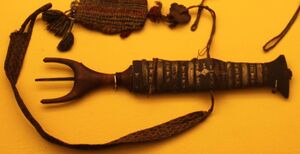Engineering:Balarao
| Balarao | |
|---|---|
  Top: A balarao from the Mandaya people (c. 1926); Bottom: A Mandaya balarao in its sheath in the National Museum of Anthropology | |
| Type | Dagger |
| Place of origin | Philippines |
| Specifications | |
| Length | 12 in (30 cm) |
| Width | 4 in (10 cm) |
| Blade type | Double-edged |
| Hilt type | ivory, metal (gold, silver), hardwood, carabao horn |
| Scabbard/sheath | hardwood, carabao horn, metal (gold, silver) |
Balarao (also spelled balaraw, bararao, and bararaw), also known as "winged dagger", is a Philippines dagger used throughout the pre-colonial Philippines. It is unusually shaped, with a double-edged leaf-like blade and a finger-fitting grip consisting of two horn-like projections at the pommel and no guards. The tang also protrudes at the back. The dagger is a status symbol among nobility and warriors and is usually finely-worked with precious metals, ivory, and horn.[1][2][3]
The dagger was described as early as the 1600s by Antonio de Morga, where he details its use by Visayans in headhunting raids. It disappeared throughout most of its range during the Spanish colonial period, though it survived to modern times among the Mandaya people, where it is known as the bayadau or badao (a name also used for gunong daggers).[1][2][3]
The dagger, as bararao, has also been described as being used by the Sambal people for headhunting in the Boxer Codex (ca. 1590s).[4]
Gallery
See also
- Punyal
References
- ↑ 1.0 1.1 "Mandaya Winged Dagger". https://www.nationalmuseum.gov.ph/nationalmuseumbeta/Collections/Ethno/Dagger.html.
- ↑ 2.0 2.1 Lawrence, Marc (2009). "Filipino Weapons from A to Z". Filipino Martial Arts Digest (Stephen K. Dowd). https://www.southbayfmaclub.com/Articles/pdf/Special-Edition_Philippine-Weaponry.pdf. Retrieved 2019-07-17.
- ↑ 3.0 3.1 De Morga, Antonio (2009). The Philippine Islands, Moluccas, Siam, Cambodia, Japan, and China. Applewood Books. p. 272. ISBN 9781429091398. https://books.google.com/books?id=ndSG3Gd6bkEC.
- ↑ Turley, Jeffrey Scott (2015). Souza, George Bryan; Turley, Jeffrey Scott. eds. The Boxer Codex Transcription and Translation of an Illustrated Late Sixteenth-Century Spanish Manuscript Concerning the Geography, History and Ethnography of the Pacific, South-east and East Asia. Brill. pp. 328-329. ISBN 9789004301542.
 |


